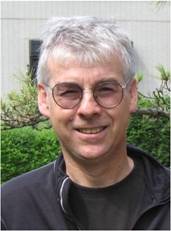
Beyond 5G

Imagine a roomful of 1,000 students all simultaneously experiencing an augmented reality lecture and demonstration. Or, how about riding in an autonomous vehicle that can detect, in real time and despite inclement weather, an accident or obstacle miles ahead? For those scenarios to be possible, we need a new, enhanced generation of wireless communication.
And that is the focus of the newly established ComSenTer, a $27.5 million center for converged terahertz communications and sensing at UC Santa Barbara, led by UCSB professor of electrical and computer engineering professor Mark Rodwell.
“Our center is simply the next next generation of communication and sensing, something that may become ‘6G’,” said Ali Niknejad, ComSenTer associate director and a UC Berkeley professor of electrical engineering and computer sciences.
The fifth generation (5G) in mobile communications is currently under active investigation by industry, with expected deployments ahead of the 2020 Olympics. This emerging network will employ higher frequency bands, more spatial multiplexing and higher throughputs than those available to consumers today.
ComSenTer’s research will go further, laying the foundation for the next generation by utilizing extremely high frequencies in the range of 100 GHz to 1 Thz. According to the researchers, this will allow for the extreme densification of communications systems, enabling hundreds and even thousands of simultaneous wireless connections, with 10 to 1,000 times higher capacity than the nearer-term 5G systems and network.
Augmented reality and next-level imaging and sensing with a terahertz imaging radar are only some of the potential applications that ComSenTer seeks to make a reality. Other possibilities include chemical sensors and new medical imaging modalities.
“We are delighted and extremely proud that Professor Mark Rodwell will be leading the ComSenTer," said Rod Alferness, dean of the College of Engineering at UCSB. “We believe that expanding and leveraging our team’s advances in terahertz and sensing technologies to direct very-broadband information signals to thousands of users offers great promise in addressing the ever-increasing future demands for wireless services.”
ComSenTer is part of the new $200 million, five-year JUMP (Joint University Microelectronics Program), a consortium of industry research participants and the U.S. Defense Advanced Research Projects Agency (DARPA), administered by Semiconductor Research Corporation (SRC). The partnership will fund research centers at six top research universities: UCSB, Carnegie Mellon University, Purdue University, the University of Virginia, the University of Michigan and the University of Notre Dame.
Each research center will examine a different challenge that advances microelectronics, a field crucial to the U.S. economy and its national defense capabilities. The six centers will collaborate to develop solutions that work together effectively. Each center will also have liaisons from the program’s sponsoring companies, which both aids in research collaboration and a proven model for technology transfer into the sponsors. JUMP sponsors come from both commercial and defense electronics industries.
UCSB also is a collaborator in two other research centers in the JUMP initiative: CRISP (Center for Research on Intelligent Storage and Processing-in-memory), led by Kevin Skadron at the University of Virginia, and ASCENT (Applications and Systems driven Center for Energy Efficient Integrated NanoTechnologies, led by Suman Datta at Notre Dame University.
SRC is a world-renowned, high technology-based consortium that serves as a crossroads of collaboration between technology companies, academia, government agencies and SRC’s highly regarded engineers and scientists.



